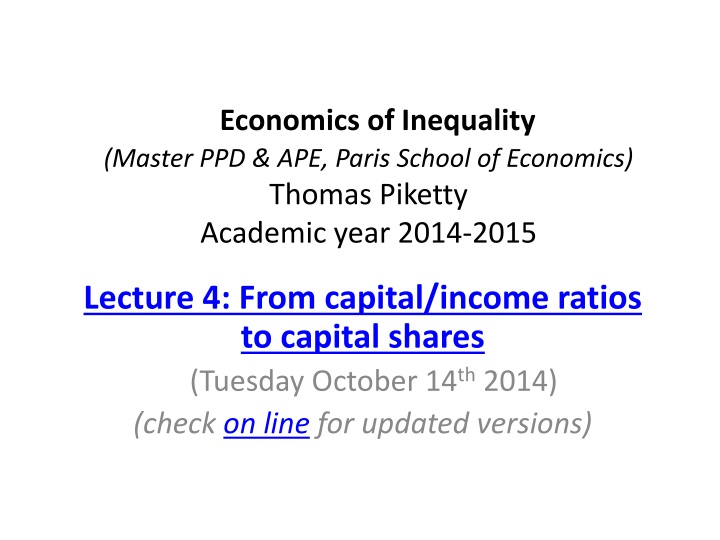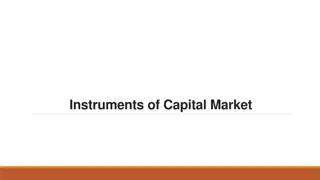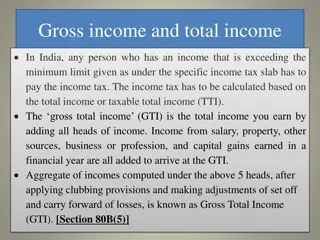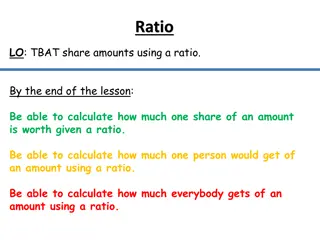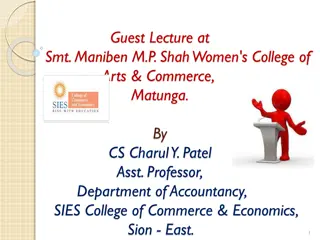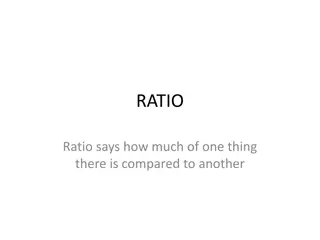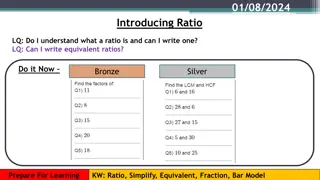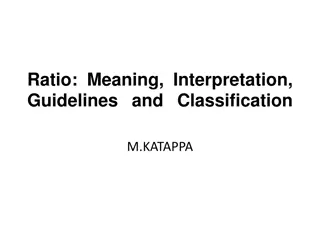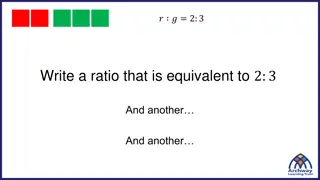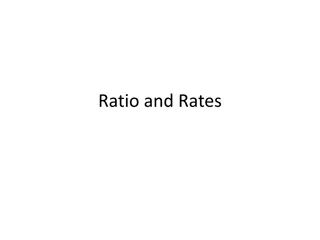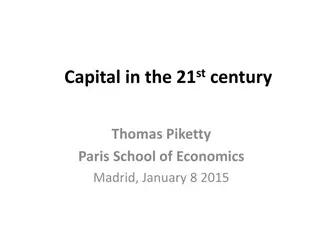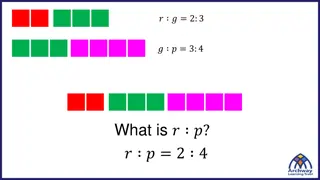Capital-Income Ratios and Capital Shares
In this lecture series, Thomas Piketty delves into the concepts of capital-income ratios, capital shares, and the Cobb-Douglas production function. He explains the relationship between capital stock, income flow, and the distribution of wealth and income in an economy. The discussion also touches on the average rate of return to capital, factors influencing capital shares, and the limits of the Cobb-Douglas model in explaining changes in capital income distribution over time.
Download Presentation

Please find below an Image/Link to download the presentation.
The content on the website is provided AS IS for your information and personal use only. It may not be sold, licensed, or shared on other websites without obtaining consent from the author.If you encounter any issues during the download, it is possible that the publisher has removed the file from their server.
You are allowed to download the files provided on this website for personal or commercial use, subject to the condition that they are used lawfully. All files are the property of their respective owners.
The content on the website is provided AS IS for your information and personal use only. It may not be sold, licensed, or shared on other websites without obtaining consent from the author.
E N D
Presentation Transcript
Economics of Inequality (Master PPD & APE, Paris School of Economics) Thomas Piketty Academic year 2014-2015 Lecture 4: From capital/income ratios to capital shares (Tuesday October 14th2014) (check on line for updated versions)
Capital-income ratios vs. capital shares Capital/income ratio =K/Y Capital share = YK/Y with YK = capital income (=sum of rent, dividends, interest, profits, etc.: i.e. all incomes going to the owners of capital, independently of any labor input) I.e. = ratio between capital stock and income flow While = share of capital income in total income flow By definition: = r x With r = YK/K = average real rate of return to capital If =600% and r=5%, then = 30% = typical values
In practice, the average rate of return to capital r (typically r 4-5%) varies a lot across assets and over individuals (more on this in Lecture 6) Typically, rental return on housing = 3-4% (i.e. the rental value of an appartment worth 100 000 is generally about 3000-4000 /year) (+ capital gain or loss) Return on stock market (dividend + k gain) = as much as 6-7% in the long run Return on bank accounts or cash = as little as 1-2% (but only a small fraction of total wealth) Average return across all assets and individuals 4-5%
The Cobb-Douglas production function Cobb-Douglas production function: Y = F(K,L) = K L1- With perfect competition, wage rate v = marginal product of labor, rate of return r = marginal product of capital: r = FK= K -1L1- and v = FL= (1- ) K L- Therefore capital income YK= r K = Y & labor income YL= v L = (1- ) Y I.e. capital & labor shares are entirely set by technology (say, =30%, 1- =70%) and do not depend on quantities K, L Intuition: Cobb-Douglas elasticity of substitution between K & L is exactly equal to 1 I.e. if v/r rises by 1%, K/L= /(1- ) v/r also rises by 1%. So the quantity response exactly offsets the change in prices: if wages by 1%, then firms use 1% less labor, so that labor share in total output remains the same as before
The limits of Cobb-Douglas Economists like Cobb-Douglas production function, because stable capital shares are approximately stable However it is only an approximation: in practice, capital shares vary in the 20-40% range over time and between countries (or even sometime in the 10-50% range) In 19c, capital shares were closer to 40%; in 20c, they were closer to 20-30%; structural rise of human capital (i.e. exponent in Cobb-Douglas production function Y = K L1- ?), or purely temporary phenomenon ? Over 1970-2010 period, capital shares have increased from 15- 25% to 25-30% in rich countries : very difficult to explain with Cobb-Douglas framework
The CES production function CES = a simple way to think about changing capital shares CES : Y = F(K,L) = [a K( -1)/ + b L( -1)/ ] /( -1) with a, b = constant = constant elasticity of substitution between K and L : linear production function Y = r K + v L (infinite substitution: machines can replace workers and vice versa, so that the returns to capital and labor do not fall at all when the quantity of capital or labor rise) ( = robot economy) 0: F(K,L)=min(rK,vL) (fixed coefficients) = no substitution possibility: one needs exactly one machine per worker 1: converges toward Cobb-Douglas; but all intermediate cases are also possible: Cobb-Douglas is just one possibility among many Compute the first derivative r = FK: the marginal product to capital is given by r = FK= a -1/ (with =K/Y) I.e. r as (more capital makes capital less useful), but the important point is that the speed at which r depends on
With r = FK= a -1/, the capital share is given by: = r = a ( -1)/ I.e. is an increasing function of if and only if >1 (and stable iff =1) The important point is that with large changes in the volume of capital , small departures from =1 are enough to explain large changes in If = 1.5, capital share rises from =28% to =36% when rises from =250% to =500% = more or less what happened since the 1970s In case reaches =800%, would reach =42% In case =1.8, would be as large as =53%
Measurement problems with capital shares In many ways, is easier to measure than In principle, capital income = all income flows going to capital owners (independanty of any labor input); labor income = all income flows going to labor earners (independantly of any capital input) But in practice, the line is often hard to draw: family firms, self- semployed workers, informal financial intermediation costs (=the time spent to manage one s own portfolio) If one measures the capital share from national accounts (rent+dividend+interest+profits) and compute average return r= / , then the implied r often looks very high for a pure return to capital ownership: it probably includes a non-negligible entrepreneurial labor component, particularly in reconstruction periods with low and high r; the pure return might be 20-30% smaller (see estimates) Maybe one should use two-sector models Y=Yh+Yb(housing + business); return to housing = closer to pure return to capital
Recent work on capital shares Imperfect competition and globalization: see Karabarmounis-Neiman 2013 , The Global Decline in the Labor Share ; see also KN2014 Public vs private firms: see Azmat-Manning- Van Reenen 2011, Privatization and the Decline of the Labor Share in GDP: A Cross- Country Aanalysis of the Network Industries Capital shares and CEO pay: see Pursey 2013, CEO Pay and Factor shares: Bargaining effects in US corporations 1970-2011
Summing up The rate of return to capital r is determined mostly by technology: r = FK= marginal product to capital, elasticity of substitution The quantity of capital is determined by saving attitudes and by growth (=fertility + innovation): = s/g The capital share is determined by the product of the two: = r x Anything can happen
Note: the return to capital r=FK is dermined not only by technology but also by psychology, i.e. saving attitudes s=s(r) might vary with the rate of return In models with wealth or bequest in the utility function U(ct,wt+1), there is zero saving elasticity with U(c,w)=c1-s ws, but with more general functional forms on can get any elasticity In pure lifecycle model, the saving rate s is primarily determined by demographic structure (more time in retirement higher s), but it can also vary with the rate of return, in particular if the rate of return becomes very low (say, below 2%) or very high (say, above 6%)
In the dynastic utility model, the rate of return is entirely set by the rate of time preference (=psychological parameter) and the growth rate: Max U(ct)/(1+ )t , with U(c)=c1-1/ /(1-1/ ) unique long rate rate of return rt r = + g > g ( >1 and transverality condition) This holds both in the representative agent version of model and in the heteogenous agent version (with insurable shocks); more on this in Lecture 6
